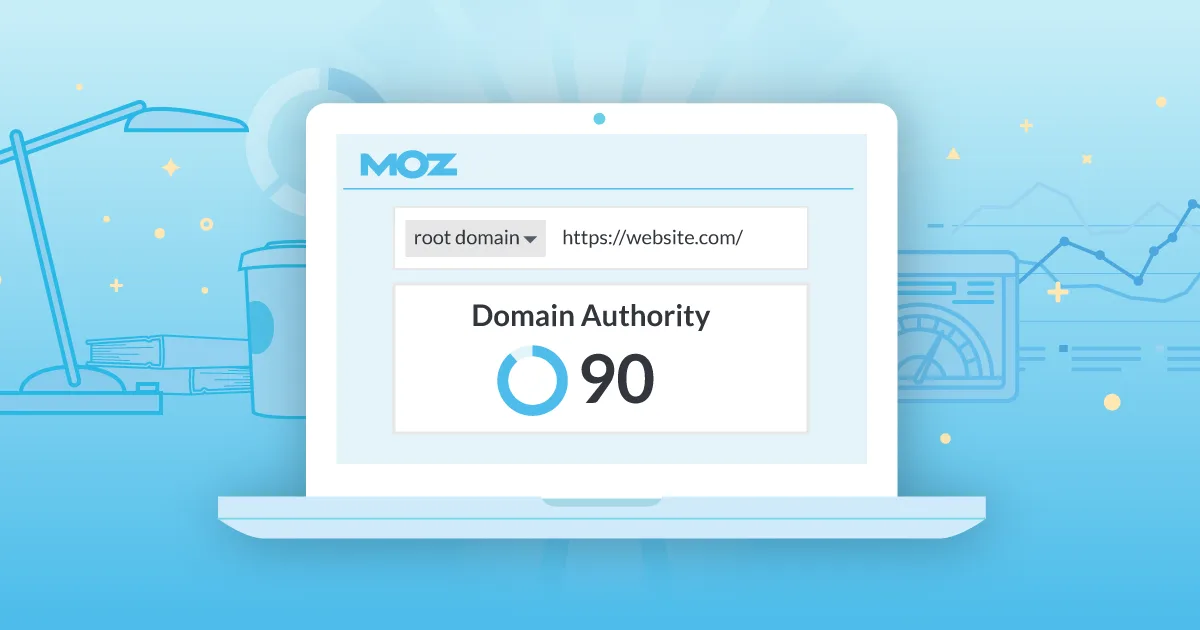Imagine your website as a host of a popular pool party and consider links as guests who show up.
No one likes those strangers with bad reputations who crash parties and create a scene. Consider them as bad links that do more harm than good.
You’ll adore buddies who help you with arrangements, dance their hearts out, and stay with you for long. They are like those high-authority links everyone likes.
Therefore, invite a great crowd that enhances your website’s visibility and provides you with high-quality links from reputable sources.
Want to know further about link-building? Below is some supreme information.
But before that let’s understand DA & DR and how they can affect your website.
What does DA mean?
Image source:- Moz
Domain Authority (DA):
- Developed by Moz
- Scored on a scale from 1 to 100
- It measures the strength of a website’s backlink profile
- Factors: Total number of links, linking root domains, MozTrust, MozRank
- Higher DA = greater ability to rank in search engines
What does DR mean?
Domain Rating (DR):
- Created by Ahrefs
- Also scored from 1 to 100
- Focuses on the strength of a website’s backlink profile
- Factors: number and quality of backlinks, the DR of linking sites
- Higher DR = stronger backlink profile and more SEO potential
What Do They Measure? Ahrefs DR vs Moz DA
1. Data Sources:
- Ahrefs DR: Uses its extensive database of backlinks, updated regularly to provide fresh data.
- Moz DA: Relies on the Mozscape index, which is also comprehensive but may have slight variations in link data compared to Ahrefs.
2. Update Frequency:
- Ahrefs DR: Updates continuously, offering near real-time data.
- Moz DA: Updates monthly, which might mean slower reflection of changes.
3. Practical Use:
- Ahrefs DR: Great for backlink analysis and competitive research. It helps you see who’s linking to your competitors and identify potential link-building opportunities.
- Moz DA: Useful for overall SEO strategy and benchmarking your site’s authority over time.
Ahrefs DR is your go-to for detailed backlink analysis, while Moz DA gives a broader picture of your site’s ranking potential. Using both in the team can give you a well-rounded view of your SEO health.
The problem with these link-building metrics
- Metrics related to link-building can be very challenging, particularly if your company is small or you have a recently launched website.
- To begin with, measures such as PageRank and Domain Authority (DA) may be deceiving. Because it can be manipulated, DA doesn’t always accurately represent the quality of a site.
- Furthermore, PageRank is useless for analysis right now because Google no longer updates it publicly.
- The quality versus quantity comes next. Although getting a lot of backlinks is appealing, quality is far more important.
- A few high-quality connections outweigh hundreds of low-quality ones every time.
- It can also be quite disruptive when search engines update their algorithms regularly. What may work today, may not work tomorrow.
- Relying too much on particular data might lead to penalties and encourage spamming practices such as link purchasing and link farming.
- Therefore, although link-building is important, obsessing on certain metrics can be counterproductive. For optimal outcomes, strive for excellence, remain up to date on developments, and use genuine link-building tactics.
How to Enhance DR Score?
If you wish to raise your Domain Rating (DR) score, then you are in luck. Because we have some awesome tricks that will help you achieve that. Come on, let’s get started!
It’s important to create content that readers desire to read rather than only producing content for multiplying your links.
Backlinks are the most crucial part of your digital reputation. So always focus on quality over quantity.
The significance of internal connectivity should not be disregarded. To strengthen your site’s structure and increase your DR, insert links across your content.
Include relevant keywords in your headings, meta descriptions, and titles. This makes your information more comprehensible to search engines.
Always keep in mind that boosting your DR score does not come with a miraculous fix. And it requires patience, time, and work.
How low DA sites rank?
Here are some straightforward tips to help your low DA site climb the SEO ladder.
Target specific keywords relevant to your content. Low-competition long-tail keywords might be your best allies.
Make sure the content you write about is instructive, engaging, and helpful to your audience.
Be mindful of your headers, image alt texts, title tags, and meta descriptions. Your site’s visibility can be increased by optimizing these components.
Prioritize quality over quantity even though you might not immediately receive backlinks from reputable websites.
Your SEO may be impacted indirectly by social signals. Promote your work on social media to increase engagement and visibility.
Why Do Domain Authority (DA) and Page Authority (PA) Fluctuate So Much?
The following factors commonly result in variations in Page Authority (PA) and Domain Authority (DA) scores:
- Search engines like Google update their algorithms regularly, which affects website rankings.
- Variations in the quantity or quality of backlinks pointing to your website may result in different scores.
- Improvements in competitors’ SEO strategies can affect your relative ranking.
How to Find High-Quality Websites for Your Link-Building Campaigns?
- To improve your link-building efforts, you can use the following tactics to find quality websites:
- Search websites that are relevant to your niche or specialization. The reputation of your website is increased by links from related websites.
- Seek for high-domain ranking websites. This measure represents a site’s overall quality and potential for greater search engine ranking; it ranges from 0 to 100.
- Use tools such as SimilarWeb or SEMrush to analyze the website’s traffic analytics. Websites with substantial traffic indicate popularity and can offer valuable exposure.
- Look for websites with active engagement on social media platforms. High social signals indicate a strong online presence and the potential for increased visibility.
- Steer clear of websites with spammy or low-quality content. Links from such sites can harm your website’s reputation and SEO efforts.
- In summary, prioritize relevance, authority, traffic, content quality, and engagement when selecting websites for your link-building campaign. Focusing on these factors will do wonders.
What are Some other SEO Metrics to Consider?
Certainly! Here are some pointers for other SEO metrics to consider, along with conversational content for each:
-
Bounce Rate:
It functions similarly to a search engine’s popularity vote for your content. The better your content is connecting with users, the greater the CTR.
Consider it as an electronic door bang. Excessive bounce rates may indicate that users aren’t engaging with or aren’t liking what they are reading.
-
Dwell Time:
How long do guests stay at your party?
The amount of time visitors spend on your website is known as dwell time.
The more time visitors spend on a website, the higher the chance of your website soaring.
-
Pages Per Session:
It’s similar to a window shopping spree. When visitors browse more pages, it means they are interested in your content, products, and services.
This metric indicates the average number of pages a visitor views during one session on your site.
-
Page Load Speed:
How quickly the pages on your website load is referred to as page load speed.
It’s similar to waiting for a friend’s text reply. You are more prone to become disinterested if it takes longer than expected.
All these factors together affect the performance of your website. So, always keep an eye on them.
Examples of Sites You Shouldn’t Target for Link Building
Choosing carefully where to obtain your backlinks is essential for link building. Cheap or low-quality links can do more harm than good, potentially leading to penalties from search engines. Here are some real-world examples of websites you should avoid when building links.
-
TopPostsToday.com
With more than 1,500 referring domains, including a few high-authority sites, TopPostsToday.com is a DR 45 site. It started operating in 2015 at the latest.
Despite claiming to be focused on technology and business news, the site gets less than 100 hits a month and has badly written articles on irrelevant subjects.
It lacks proper contact information and transparency about ownership. Inactive social media buttons indicate poor maintenance, suggesting the site is primarily set up for SEO manipulation.
It appears to be an expired domain repurposed for link building, making it a poor choice for acquiring SEO links.
-
GlobalNewsTrends.com
GlobalNewsTrends.com boasts a DR 50 and has numerous referring domains. It has been online since 2013.
With only about 75 visits per month, audience engagement is low.
The site features poorly written articles on random topics, clearly aimed at SEO rather than providing value.
The lack of contact information and clear ownership details cast doubt on the site’s legitimacy.
Inactive or nonexistent social media links indicate poor maintenance.
-
YourDailyDigest.net
YourDailyDigest.net has a DR of 42 with a substantial number of referring domains, which has existed since 2016.
The site attracts just 60 visits per month, according to Ahrefs.
Despite claiming a focus on lifestyle and finance, it features low-quality articles on random topics like payday loans, generic health advice, and dubious tech reviews.
The site lacks detailed contact information and does not disclose its owners or contributors. Social media buttons either lead to inactive profiles or nowhere at all.
This appears to be an expired domain repurposed for link building. Avoid links from such sites to mai
This website appears to be another example of a domain that has expired and been hijacked to obtain links. Maintaining a strong and successful SEO strategy requires avoiding links from these types of websites.
Examples of Valuable Sites
Here are some examples of lesser-known yet valuable sites for earning backlinks.
1. TechGenix
TechGenix offers in-depth tutorials and articles about IT and technology-related issues,
Along with an About page and a Contact page, the website has a thorough author biography.
High domain authority, regular updates, and a strong focus on a specific niche.
2. Datafloq
Big data, blockchain, and artificial intelligence are the main areas of concentration for Datafloq.
Here, industry leaders share high-quality and well-researched content.
It has clear information about contributors, an About Us page, and comprehensive contact information.
It focuses on a niche with a high level of expertise, providing valuable backlinks.
3. TechBullion
Technology, financial, and business advances are all covered by TechBullion.
In-depth, up-to-date articles authored by skilled writers are featured on the website.
Transparent about the team, with a detailed About page and easy-to-find contact information.
Strong niche relevance and consistent content updates make it a good backlink source.
4. DZone
DZone offers articles, tutorials, and news for software developers and IT professionals.
High-quality, technical content from experienced contributors.
The site has a clear editorial process, an About page, and contact information.
High domain authority and focused content relevant to the tech industry.
Conclusion
The secret to maximizing the SEO performance of your website is to fully understand the nitty-gritty of Domain Authority (DA) and Domain Rating (DR).
Although DA provides a general evaluation of site authority, DR goes more into backlink strength. Using both indicators gives you a comprehensive understanding of your SEO environment.
But keep in mind that producing high-quality content, encouraging interaction, and keeping up with changing trends are all important for SEO performance in addition to numbers. Therefore, concentrate on relevancy, quality, and building real connections with your audience.








